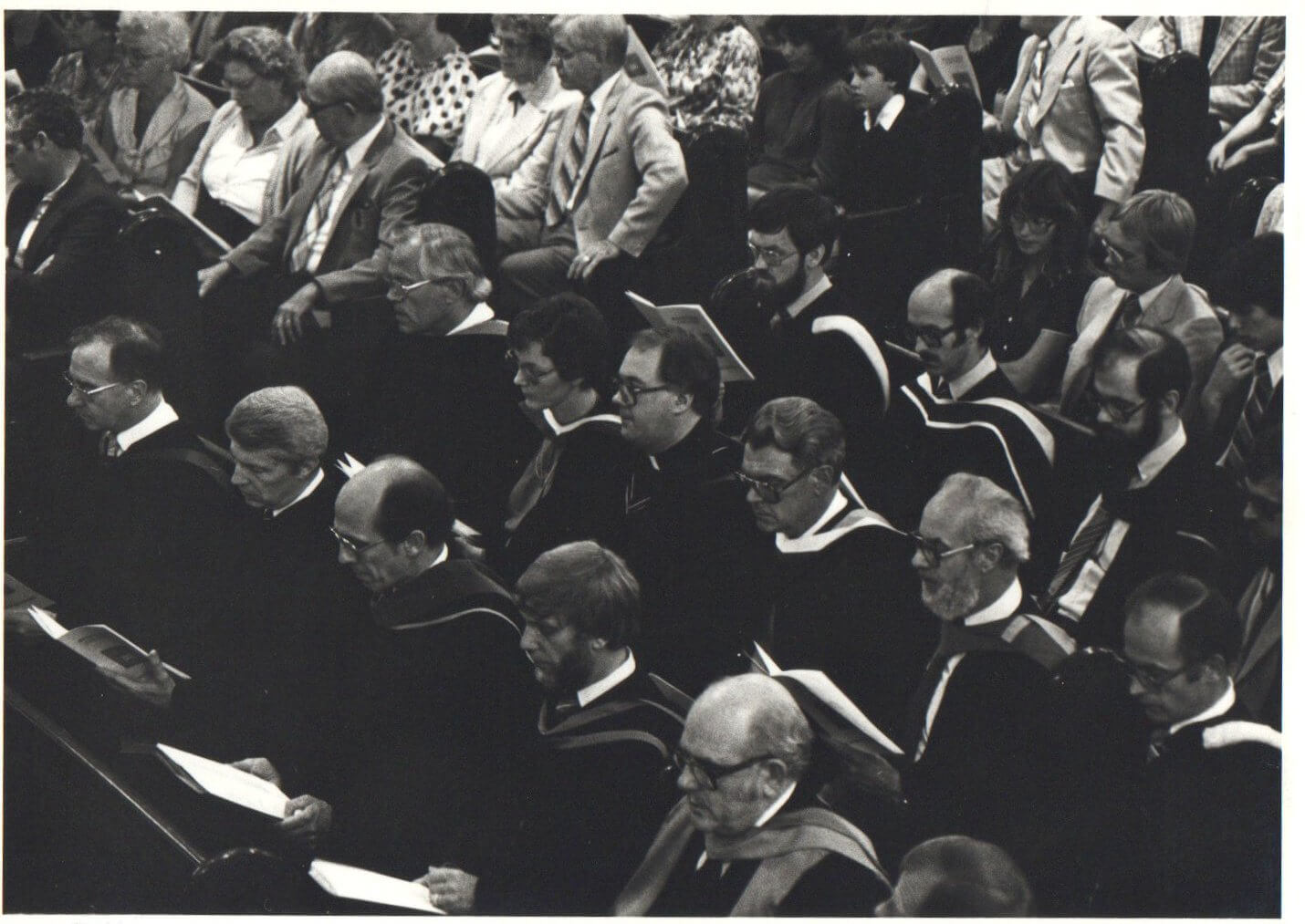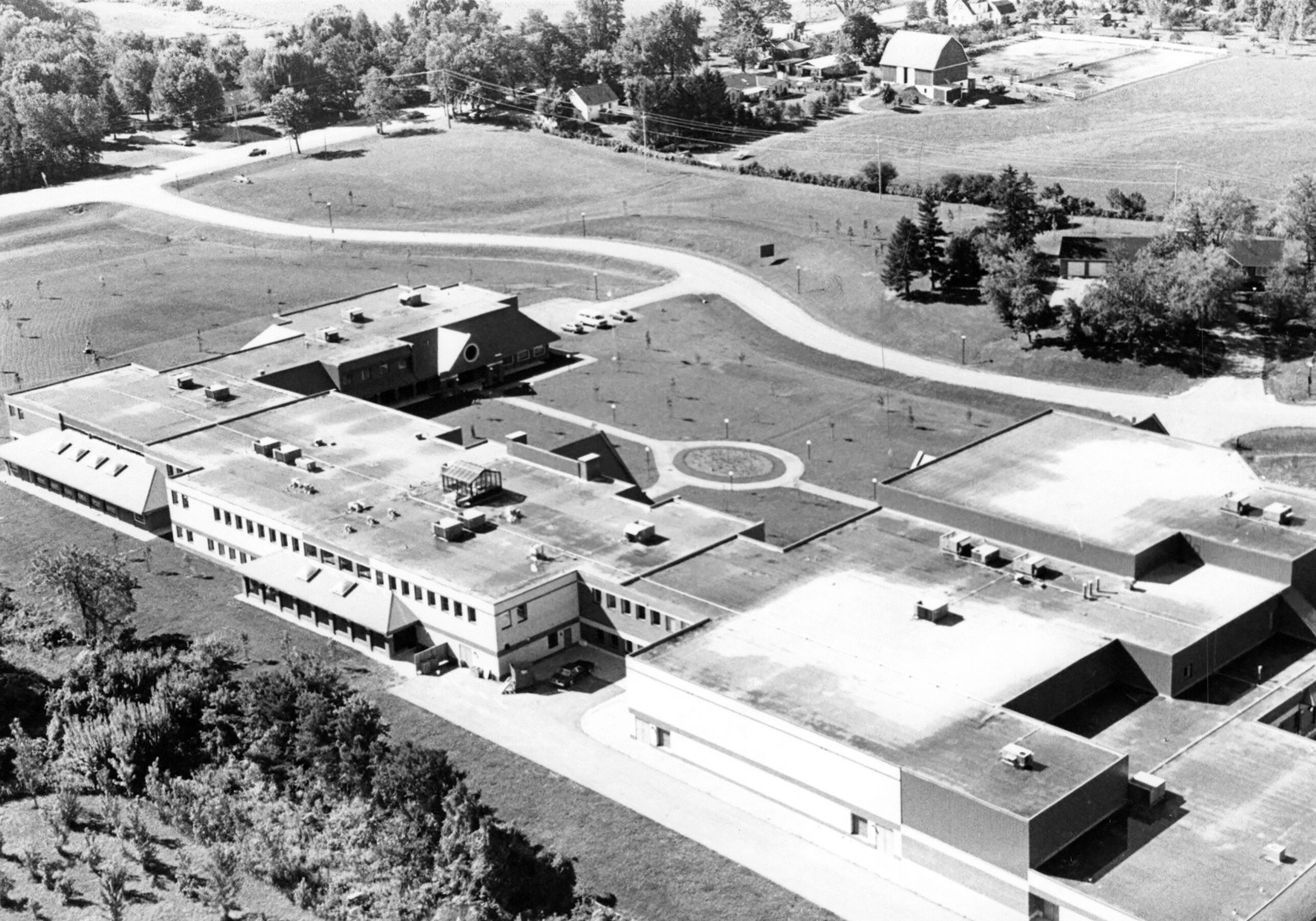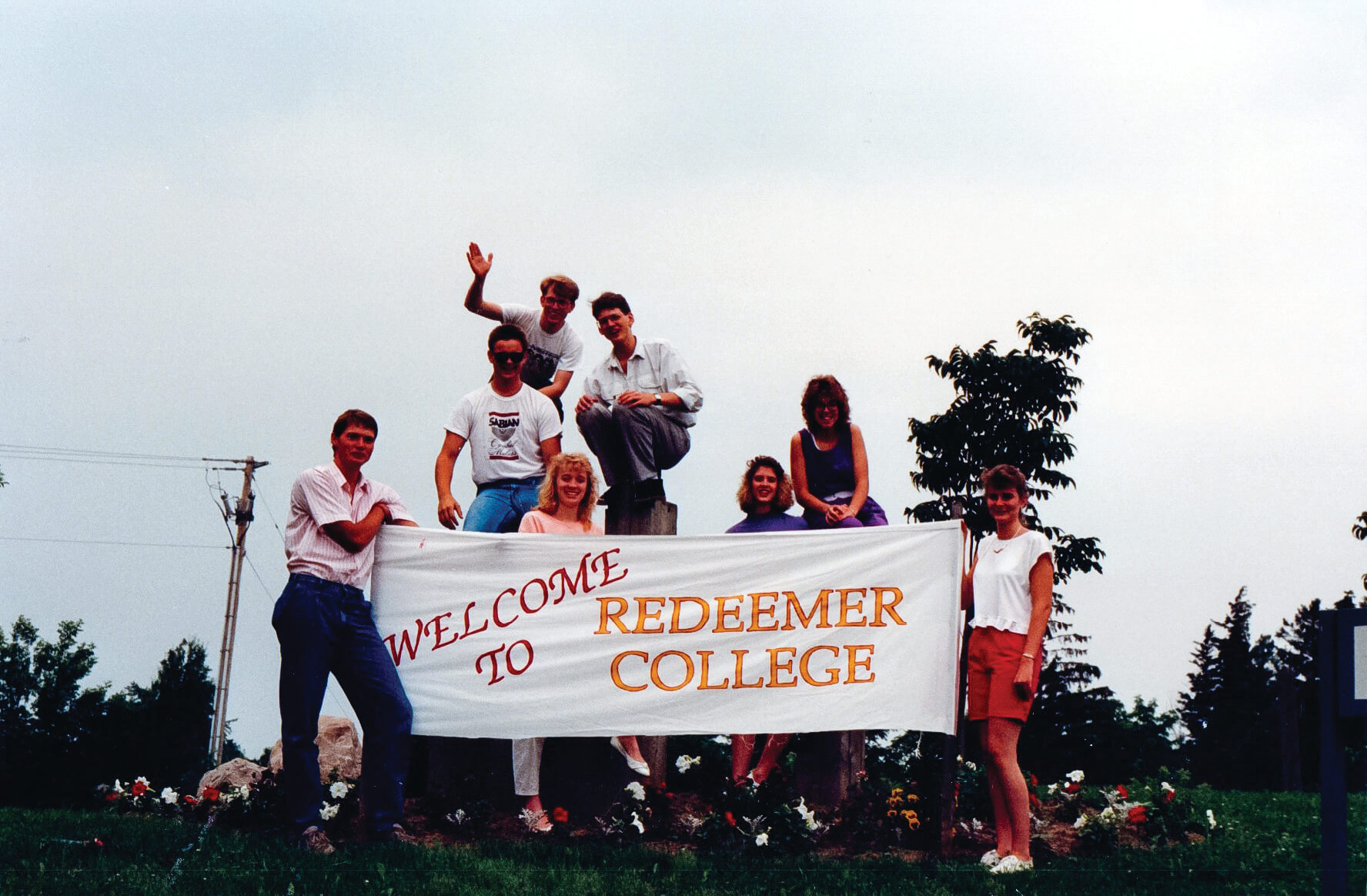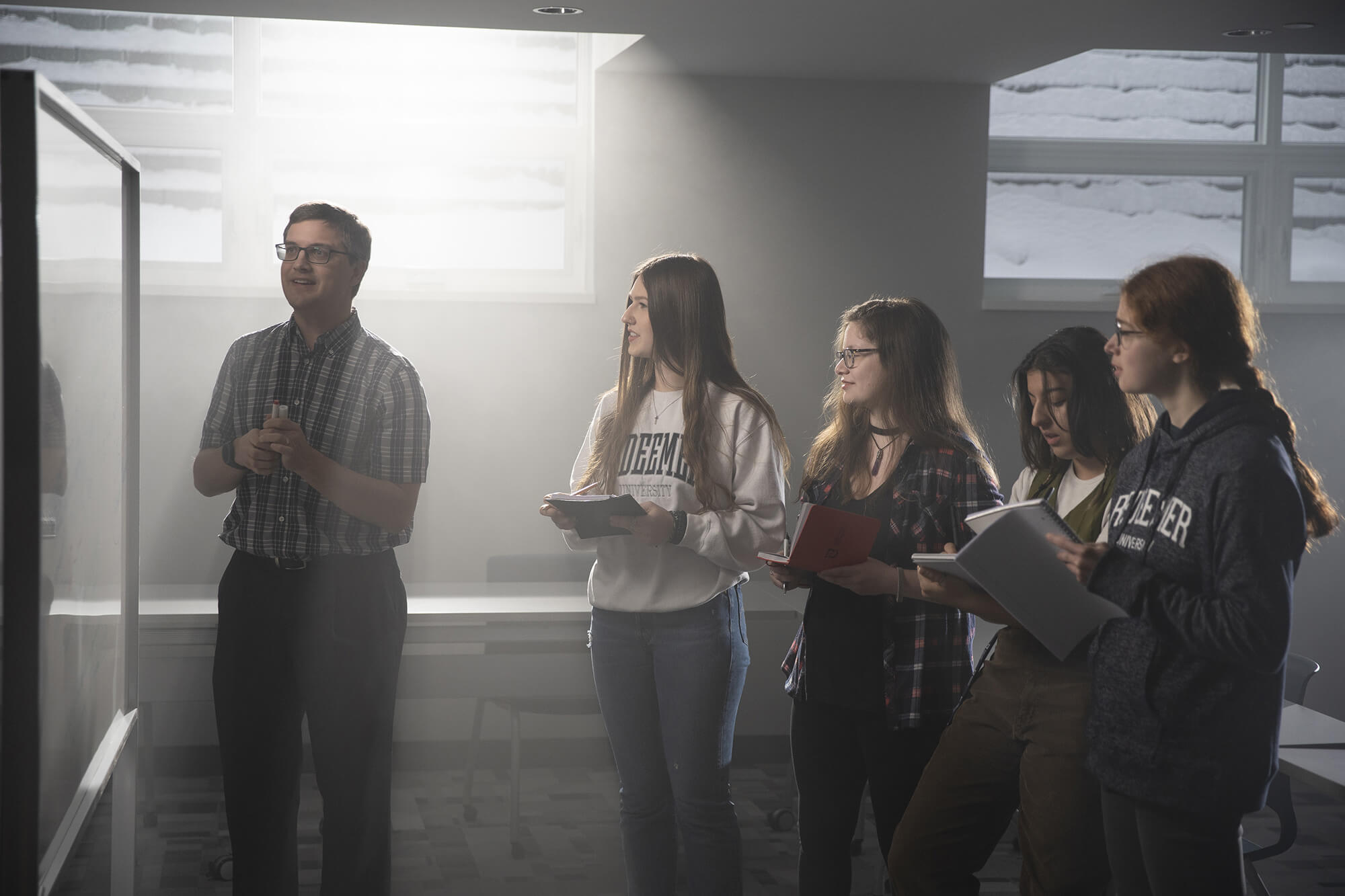Redeemer began as an idea. Over the course of many years, it became clear that it was part of God’s story as he worked miracle after miracle, against many obstacles, to birth and sustain an institution whose graduates would spread his love and hope in their careers and communities for his glory.
In the Beginning
Founding president, the late Rev. Dr. Henry De Bolster was visited by a local Christian businessman from his church in 1974 with the idea of studying the feasibility of starting a Christian college in Ontario. De Bolster soon developed a passion for the idea that drove him to see past financial and regulatory obstacles, and take many steps of faith.
A distinctly Reformed constitution was drawn up for the college. Over the next few years, the road to establishment was at times disheartening. Attempts to affiliate with local Ontario universities failed, and in early 1980 a bill allowing a privately funded Christian university college failed as well. Finally, The Redeemer College Act, officially recognizing Redeemer Reformed Christian College and its charter, was passed in December 1980.
“Finally, we were officially recognized by the government of Ontario,” said De Bolster in his book Stepping Forward in Faith, which details the first 20 years of Redeemer’s story. “It was the end of a lengthy struggle. Receiving our charter was nothing less than a miracle worked by our heavenly Father.”
In 1981, De Bolster was appointed Redeemer’s first president and on October 31, Reformation Day, he was inaugurated at Centenary United Church in Hamilton.

“The ceremony was moving. It impressed on me both the tremendous privilege as well as the awesome responsibility that rested on my shoulders. At the same time, I knew that the Lord would guide me and that the prayers of God’s people would accompany me,” said De Bolster. Redeemer’s official coat of arms and motto – Agnus Dei, Rex Omnium (Lamb of God, King over All) – were also presented at the ceremony.
The Early Years
Redeemer would continue to experience the trials and joys of the work involved with setting up the new institution. On September 6, 1982, Redeemer College opened its doors with a mission to offer a liberal arts and sciences program from a Reformed Christian perspective, emphasizing the lordship of Jesus Christ over all of life and learning. Ninety-seven full time students began their post-secondary studies in Redeemer’s initial temporary home at Bell Cairn School on Beach Boulevard in Hamilton.
“There was this sense of being in a dream!” said Dr. Justin Cooper, the youngest member of the original eight faculty members, who would later take over as president. “It was delightfully demanding. New challenges would come year after year. Many new students came. We were building the plane as we were flying it. In four years we went from nothing to a four-year institution. I don’t think that’s happened anywhere else.”
Dr. Al Wolters, professor emeritus of religion and Greek, described the early days as an exciting time. “People were engaged in a new project; they were excited about it. The new faculty were young. They were in their 30s and 40s; they were all kind of idealistic. There was kind of a spirit of adventure. Sort of being in a common task for a noble ideal.”
“I almost rolled off my chair…what an answer to prayer. For me it was as if the Lord was saying ‘Go ahead, build the campus, I will be with you.’”
“Faculty, staff and students were really a united bunch,” said Elizabeth Williams, who recently retired as departmental assistant in student life, but who had worked in recruitment in those early years. “We all had lunches together in the cafeteria, so conversations at lunch time were always lively and fun. They could be everything from the inane to a whole discussion about something they had studied in class, but everybody was really a solid group. A lot of friendships were made at that time between faculty, staff and students that remain until this day.”
Tim Wolfert, a student at Redeemer in 1983, lived in the original student residences – townhomes on Francis Road – and has memories about the sometimes unpredictable circumstances of those early days. “We were living in Burlington, commuting five kilometers to campus every day. It was like you didn’t know what was going to happen from one day to the next. The lift bridge would be open and you’d end up being a half hour late for class.”
With the decision to expand beyond a two-year program, a committee began searching for a permanent campus in January 1984. The work was greatly invigorated that July when an anonymous donor with a “very warm heart” for the college gave $1 million towards the development of the new campus.
“I almost rolled off my chair,” De Bolster writes in his book. “What an answer to prayer. For me it was as if the Lord was saying ‘Go ahead, build the campus, I will be with you.’”
In 1985, the college purchased 78 acres of land in Ancaster. On June 22, the groundbreaking ceremony took place with Psalm 127:1 as the guiding verse. “Unless the Lord builds the house, its builders labour in vain.” The following summer Redeemer moved to the new Ancaster campus initially made up of the academic building, 36 residence-style townhouses, 20 apartment- style units and a student recreation centre.

The new facilities were an impressive upgrade from the rented space at Bell Cairn School. “I started at the Beach Boulevard campus, and teaching chemistry in a kitchen was a challenge,” says Dr. Henry Brouwer, professor emeritus of chemistry. “One of the highlights was moving to the new campus and having brand new labs, that’s for sure!”
1985 also brought recognition of Redeemer’s bachelor of Christian studies (BCS) as comparable and equivalent to bachelor of arts (BA) or bachelor of science (BSc) degrees; it was also regarded as such by almost all post-graduate programs. This was a significant victory for Redeemer and its graduates.
The following decade saw enrolment growth and program expansion including, French, business, education and chemistry. The music department opened in 1986 and presented many memorable concerts over the decades. Theatre arts opened and hosted its first production in 1987.
Growing Up
In the spring of 1994, De Bolster retired and on October 21 of that year, Dr. Justin Cooper was inaugurated as Redeemer’s second president. His memories of his time as president are marked by God’s steady faithfulness. Cooper recalls that the landscape in the mid-90s was difficult because students were beginning to desire regular BA and BSc degrees, rather than equivalents.
Enrolment had been decreasing and there were significant budget pressures. But often just when things were looking most bleak, God would open a new door for Redeemer. The government at the time had put together a committee to study whether a private university could grant degrees. In that favourable climate, Redeemer was able to apply in 1998 for a charter amendment.
Cooper and his team were scheduled to present their case to the Council of Ontario Universities (COU) and on the day of the presentation Cooper says things were feeling tense.
“We opened the door and the president of the COU said to me, ‘I know you probably have a big presentation ready, but I just want you to know that we’re not going to oppose your request.’”
Earlier that day university presidents in the COU discussed the Redeemer graduates who had enrolled in their graduate school programs. Each president agreed that they were good students who had been taught to think critically, so they were supportive of Redeemer’s request.
“So it really was our students that the Lord used to open the door through what they had done,” said Cooper. “And we felt like the Israelites who had shown up, but the Lord had already been there ahead of us and won the battle.”
“What I am most proud of and thankful for is that the Lord used Redeemer to change the climate of university education in Ontario.”
On June 25, 1998, the Ontario government granted Redeemer the authority to offer full BA and BSc degrees. This decision officially put its programs on the same level as other Ontario universities. Building on this amended charter, on June 22, 2000, the Ontario legislature approved an institutional name change: Redeemer College officially became Redeemer University College.
“Enrolment increased dramatically,” said Cooper. “There were students who were really hungry for this kind of education and they just needed that assurance that they would have a university degree. Then they started to come.”
Another exciting development also began to take shape. On June 26, 2003, Redeemer was granted the authority to offer a bachelor of education degree to replace the bachelor of Christian education degree. In 2004, the program was fully accredited by the Ontario College of Teachers, giving Redeemer the only provincially recognized Christian teacher education program and enabling graduates to receive the Ontario Teachers Certificate and teach in Catholic, public or private Christian schools.
Increasing enrolment drove several facility expansions over the following years. A south wing addition with new lecture halls and an expanded library were completed in 2005. A second entrance to the campus at Kitty Murray Lane was added in 2006. 2008 brought the discovery of an Attiwandaron (Neutral People) village dating to 1325 and consisting of at least five (and possibly up to eight) longhouses. Many unique artifacts were found on the site. With excavation complete, the Redeemer Sports Complex, an indoor soccer dome facility, was constructed as part of an effort to upgrade sports facilities. Many of these upgrades were spurred by a one-time federal capital program fund for universities called the Knowledge Infrastructure Program (KIP) grant. In 2011, further renovations were completed on the administrative wing, putting admissions and student services on the ground floor to better welcome students.
With the increasing and diversifying student population and accompanying faculty growth came a fresh expression of Redeemer’s religious identity and founding vision in 2003. A committee worked to publish The Cross and Our Calling, an accessible foundational document for the institution that maintains its relevance and importance today.

On June 30, 2010, after 30 years of service and 16 years as president, Dr. Justin Cooper retired as president emeritus. Hundreds of supporters gathered in the auditorium to celebrate his remarkable legacy at Redeemer.
“What I am most proud of and thankful for is that the Lord used Redeemer to change the climate of university education in Ontario,” said Cooper. “So now it is accepted … that there are privately funded faith-based universities, they’re recognized as legitimate and they have their place in the arena of higher education in Ontario. And the name of Christ is honoured!”
Challenge and Change
The decade following Cooper’s retirement brought significant challenges for Redeemer. As a result of the financial crisis of 2008, demographic decline in university-aged population and a significantly higher tuition compared to publicly funded universities, Redeemer began to experience enrolment decline. Redeemer’s third president Dr. Hubert Krygsman led the university during this challenging time from 2010 to 2016. While some difficult decisions were made to ensure program sustainability, new program initiatives such as the restructuring of the core program and the addition of the health sciences program were also implemented. In 2014, a new strategic plan was launched with a goal to raise $20 million.
In 2016, the Redeemer community mourned the passing of its beloved founding president. De Bolster’s life and legacy were celebrated by faculty, staff, students and the larger community in a ceremony held in the auditorium.
Len De Bolster, Henry’s son, says his father always had a love for Christian education. “Redeemer sort of took it to the next level,” he says. “And I think the thing that drove him was a really strong belief that it is just imperative that as we grow up we need to learn how to serve in the Kingdom of God and he wanted us to learn that. He wanted the community to learn that and he wanted to learn to live that himself.”
Exciting developments flowing from the strategic plan continued during this time. In 2015, the Centre for Christian Scholarship (recently renamed the Wolters Centre) was launched, with an ambitious vision to maximize Redeemer’s scholarly impact. The Centre for Experiential Learning and Careers (now the Career Centre) was launched in March 2017, with the aim to triple the number of programs with co-op and experiential learning opportunities and help students connect their calling with individualized career guidance. In December, Redeemer, along with McMaster University and Mohawk College, partnered with the City of Hamilton on their CityLAB pilot program (now a permanent program), bringing together student, academic and civic leaders to work on real projects that create a better Hamilton. In March 2018, Redeemer launched its new program in urban and intercultural ministry, which wove together missions, theology and practical ministry.
Later in 2018, Redeemer inaugurated its fourth president, Dr. Robert Graham. And in 2019, in partnership with five Christian high schools, Redeemer launched gap-year program Act Five. Despite all these positive developments, Redeemer still faced financial difficulties and flat or shrinking enrolment.
That all changed in early 2019, when God worked another miracle for Redeemer. The generous support community gave $11 million over five years to fund a tuition and fee restructuring plan that would put Christian university education within reach for many more students. This was a game changer.

“We had been wrestling with how to make Christian university education affordable for some time,” said current president Dr. David Zietsma, who was vice president for external relations and enrolment at the time.
“Without this proactive change, tuition would likely have crossed the $20,000 threshold in five or six years. Every year, hundreds of applicants to Redeemer ended up going elsewhere, and for well over half of them, financial viability was the number one barrier.”
Lower tuition led to significant enrolment growth over the following years. The university is still on track to double undergraduate enrolment within five years for a total enrolment of over 1,200 students despite its most recent challenge of operating through a global pandemic.
A Bright Future Ahead
Enrolment growth has spurred momentum across the institution over the past few years, despite the COVID-19 pandemic. Since 2020, the institution has received ministerial consent to change its name to Redeemer University; gained authority to grant 20 possible new degrees including masters degrees, and launched two of those new degree programs, the bachelor of business administration and bachelor of kinesiology; launched a new strategic plan; appointed its fifth president; and opened a new facility at the heart of campus, the Charis Live and Learn Centre.
“Redeemer is well positioned for a bright future,” said Zietsma, who was appointed president in March 2022. “We’ve really focused on translating the theological and philosophical foundation, which is very strong, more intentionally to students in terms of how it impacts their lives, sorting through their callings, where they’re going to serve God after they leave Redeemer.”
“Redeemer is interesting in that it boldly claims what many would consider an outrageous worldview: The mission of Christ.”
Carina Wolfert, Tim’s daughter and a fourth-year student, has benefitted from this intentionality. “Redeemer is interesting in that it boldly claims what many would consider an outrageous worldview: The mission of Christ. But then you get to actively pursue that and seek it out through different things, like math and psychology and English,” she says. “And at Redeemer I just love that we get to go deep and get to explore things richly … That has been an emerging theme throughout my time at Redeemer.”
Susan Van Weelden, dean of Redeemer’s School of Business, has kept in touch with many of the students she has taught over the years, and is always excited to see how they are making an impact. “Every class brings with it new excitement,” she says. “I’m excited to see what they’re going to do and how they’re going to change the world. We have graduates all over the place and it’s just exciting for me to see their progress.”
One of those graduates, Graham Cubitt ’01, director of projects and development at Indwell, is a perfect example of this. “Redeemer prepared me as a student for entering the world with an open mind. Being able to take information from different sources and process that through a lens of integration,” Cubitt says. “Learning how to think. Learning how to work through complexity and actually come up with an opinion and come up with a path forward. I think Redeemer has an important role to play in preparing students to be active participants in addressing the complex world that we live in and being hopeful at the same time despite the challenges that we all face.”
A relevant liberal arts and sciences education that translates into the next generation of leaders serving in their communities and callings for the sake of the gospel is what Redeemer has always been about. That continues to attract and excite students 40 years on.
“There’s a hunger for meaning and purpose in the world around us,” said Zietsma. “One of the things that excites me about Redeemer’s vision is that we seek to ground students in a broader understanding of their purpose in the world, a broader story of God’s unfolding work in the world that allows them to bring hope and transformative love to the communities, organizations and ministries that they’re going to be working in.”
Where will Redeemer be 40 years from now?
“I think for any of us involved in supporting, leading, working at Redeemer, I think the hope is always that no matter whether it’s 10, or 20, or 40 years, that the university will be relevant and meaningful in having an impact, and I think most of all faithful – faithful to the gospel, faithful to the hope that we have in Christ, that he will make all things new, and that we can begin participating in that work now. That the university can ground students in that world and life view that will have a transformative impact wherever they go.”
Visit the 40th Anniversary website to view a historical timeline and a special video presentation celebrating 40 years of Redeemer.